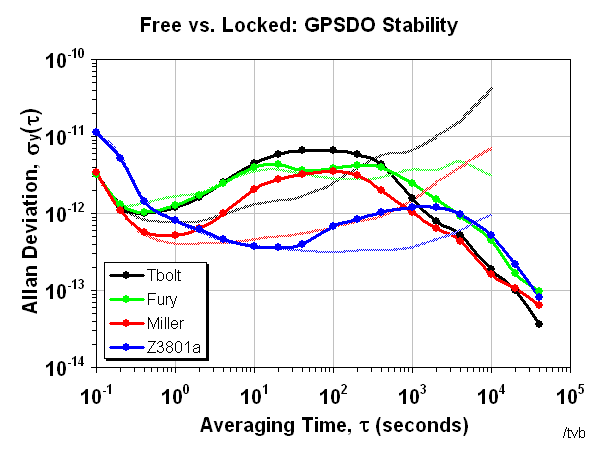There's more that's right with your graphs than you might think.
Remember that at any value of Tau, an Allan Deviation graph shows you an RMS combination of the performance of your measurement system, your reference, and your DUT (Device Under Test). In this case, you could say we have two DUTs, but that's okay. For us hobbyists, our measurement system is typically the worst part of the system so it shows up first. If GPS is involved, you can usually pick out its contributions.
Let's start at Tau = 1 sec. The red graph shows ~ 3e-11. The 53132A is spec'ed as having a 150 ps resolution. Your measurement of 30 ps means that the counter is doing averaging. That may be okay. I never use frequency for measurements like this because I'm always suspicious of things like that. They tend to make things look better than they really are. I prefer a nice, clean, simple time interval. But, even so, it's the worst performer so from Tau = 1 sec. up to Tau = 10 sec. the 53132A is all you're seeing because if you measure its noise floor, that's what you will see. [1] So we know that the PRS10 must have a lower (better) ADEV. But why is the blue graph 10 times worse? We know it's not the counter or the PRS10, so it has to be the GPS or perhaps your test setup. Check the settings on the counter. If you're triggering on a sine wave, you probably want AC coupled triggering at, or maybe slightly offset from, zero volts. If you're triggering on a 1 PPS signal, you want DC triggering at about 1/2 of the pulse's amplitude. Adjust these as necessary for your exact situation. Inspecting the signals with a 'scope may be beneficial.
Now let's move to Tau = 10 sec. through to 1000 sec. First, regarding the wiggles - they're trivial. If you can get rid of them by grooming your test setup, great! If not, don't worry about it. Even though the blue graph is high, it's starting to show GPSDO behaviour. It first tries to level out. This shows the performance of the internal oscillator. It then starts to curve down exactly as it should. As it cruises through 1000 sec. it's right on target. The red graph also looks good. Since the graph is basically straight from 1 sec. you know that's the 53132A you're seeing. So the PRS10 must be better than that. Then, at 100 sec. it switches and starts rising. That's the PRS10 rising past the counter and becoming visible. A rising curve like that suggests aging. Was the PRS10 - or some other part of the system - still warming up? Even a locked Rb needs time to settle down. Also, look at the value. We're down in the e-13 range!!!
Now let's look around 3000 - 4000 sec. Here the blue graph goes off the rails. It looks like it's NOT being disciplined anymore. I don't know what to make of that. More investigation would be required. But the red graph looks good. Despite the apparent aging of the PRS10, the graph turns and follows GPS. Why? Because you used the GPSTM as the reference for your 53132A so you have to expect the GPS 'signature' to appear in your data! That's why I NEVER use a GPSDO as my reference. A GPSDO is a perfect frequency reference, but it can color your data as we're seeing here. My old reference was an Efratom FRK Rubidium. My current one is an HP 5065A Rubidium. Here's my favorite picture that shows the GPS signature. Look at the graphs with the bold colors and dots. Four different types of GPSDO and they all end up running down, to the right, in parallel.

Bottom line here is that your measurements are pretty much what's expected. The only outlier is the high-Tau performance of your 1 PPS source as shown in the blue graph.
FYI, I've attached a recent data run I did where I compared my FTS 4065A to my HP 5065A. I included the specified limits for the 4065A. First you see my measurement system. Then you see the 4065A. It's only when you get past 10K seconds that the 5065A starts to appear.
By the way, you don't have to run Timelab in "Talk only" mode. It natively supports the 53132A. I don't know if that gives you any additional capabilities or not.
Ed
[1] I'm really not sure how to measure the frequency noise floor. Extend the gate time?
You can measure the time interval noise floor by starting with a good quality signal. If your PRS10 is configured for 1 PPS out, use that, otherwise use the 10 MHz output. Split the signal in two, preferably with a good 50 ohm splitter, but a BNC T-connector will do. Feed the two signals through different length coax cables to the Ch 1 and Ch2 inputs of the 53132A. Measure Time Interval from 1 to 2. Don't let the cables move or vibrate or change temperature. Let Timelab collect the data for a few hours. Your ADEV should show a straight line dropping down with a slope of -1. This will be a factor in every measurement you take with that counter.
Edit: I mixed up Time Interval & Frequency measurements/limits. Hopefully, this straightens things out.
